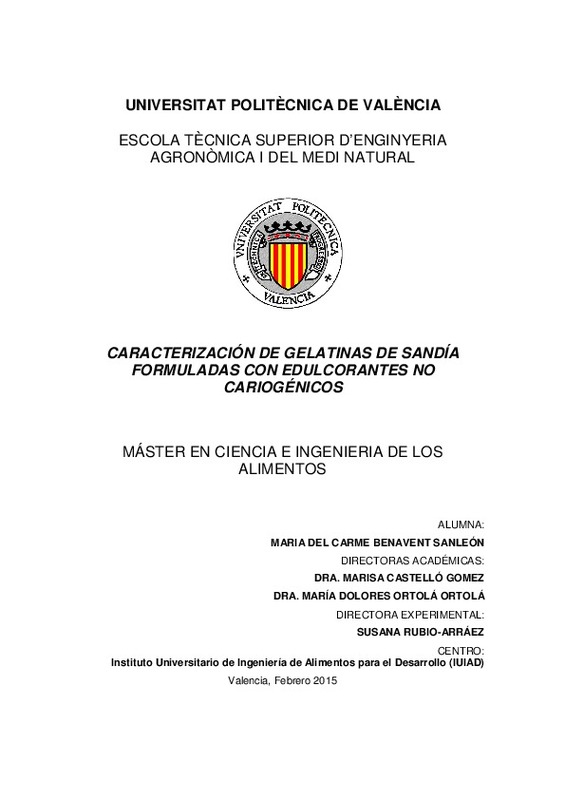JavaScript is disabled for your browser. Some features of this site may not work without it.
Buscar en RiuNet
Listar
Mi cuenta
Estadísticas
Ayuda RiuNet
Admin. UPV
Reformulación de gelatinas de sandía con edulcorantes no cariogénicos
Mostrar el registro sencillo del ítem
Ficheros en el ítem
| dc.contributor.advisor | Ortolá Ortolá, Mª Dolores
|
es_ES |
| dc.contributor.advisor | Castelló Gómez, María Luisa
|
es_ES |
| dc.contributor.author | Benavent Sanleón, María del Carme
|
es_ES |
| dc.date.accessioned | 2015-07-20T10:36:01Z | |
| dc.date.available | 2015-07-20T10:36:01Z | |
| dc.date.created | 2015-02-27 | |
| dc.date.issued | 2015-07-20 | es_ES |
| dc.identifier.uri | http://hdl.handle.net/10251/53470 | |
| dc.description.abstract | [ES] El creciente interés por mejorar los hábitos alimentarios de la sociedad afecta considerablemente al sector de los postres. Así, la sustitución de los azúcares convencionales por otros edulcorantes/azúcares junto con una mayor incorporación de la fruta a la dieta se relaciona con una mejora en la salud. Por ello, el objetivo de este trabajo ha sido evaluar en gelatinas la sustitución de la sacarosa por edulcorantes no cariogénicos y de bajo índice glucémico (isomaltulosa y tagatosa) así como la incorporación de licuado de sandía fresca, analizando la composición (ºBrix y humedad), pH, actividad de agua, capacidad antioxidante, las propiedades mecánicas y ópticas y su estabilidad con el tiempo, comparando los resultados con una gelatina control (con sacarosa) y con una gelatina comercial. Asimismo se ha realizado una evaluación sensorial de las gelatinas de sandía para ver su aceptación. Los resultados ponen de manifiesto que las gelatinas formuladas con los nuevos edulcorantes presentaron menor concentración de sólidos solubles. Por otra parte, la capacidad antioxidante aumentó con el tiempo de almacenamiento en la gelatina control y en la que contenía la mezcla de isomaltulosa y tagatosa, sin alcanzar los valores de la comercial debido a su enriquecimiento con vitamina C. Además, los nuevos edulcorantes no afectaron a la textura instrumental de las gelatinas, siendo muy estables con el tiempo. En cambio, el color sí varió, especialmente cuando se incorporó sólo tagatosa. Por último, a nivel sensorial, la gelatina con una combinación de tagatosa e isomaltulosa en igual proporción alcanzó una puntuación similar a la gelatina comercial, mostrando la viabilidad del empleo de estos edulcorantes para la reformulación de gelatinas. | es_ES |
| dc.description.abstract | [EN] Society has a great interest in improving eating habits and this affects the sector of desserts. Thus, the replacement of conventional sugars by other sweeteners and sugars along with a higher incorporation of fruit to the diet is associated with a health improvement. For that, the aim of this study was to evaluate the substitution of sucrose by sweeteners which are non-cariogenic and have low glycemic index (isomaltulose and tagatose) in gelatines as well as the addition of watermelon juice, analysing the composition (ºBrix and humidity) pH, water activity, antioxidant capacity, mechanical and optical properties and their stability over time of the samples, comparing the results with a control gelatine (with sucrose) and with a commercial gelatine. Also a sensory evaluation has been performed of watermelon gelatines for acceptance. The results show that the gelatines made with the new sweeteners had lower soluble solids. Moreover, the antioxidant activity increased with storage time in the control and in the gelatine containing isomaltulose and tagatose but without reaching the levels of the commercial one due to its enrichment with vitamin C. In addition, new sweeteners did not affect the gelatine instrumental texture, being very stable with time. Instead, the colour changed especially in the gelatine containing only tagatose. Finally, the gelatine formulated with a combination of tagatose and isomaltulose in equal proportion achieved the same score in the sensory evaluation as the commercial gelatine, showing the feasibility of using these sweeteners to reformulate gelatines. | es_ES |
| dc.language | Español | es_ES |
| dc.publisher | Universitat Politècnica de València | es_ES |
| dc.rights | Reserva de todos los derechos | es_ES |
| dc.subject | Colour | es_ES |
| dc.subject | Isomaltulose | es_ES |
| dc.subject | Tagatose | es_ES |
| dc.subject | Watermelon | es_ES |
| dc.subject | Gelatine | es_ES |
| dc.subject | Gelatina | es_ES |
| dc.subject | Sandia | es_ES |
| dc.subject | Isomaltulosa | es_ES |
| dc.subject | Tagatosa | es_ES |
| dc.subject | Textura | es_ES |
| dc.subject | Color | es_ES |
| dc.subject | Sensorial | es_ES |
| dc.subject.classification | TECNOLOGIA DE ALIMENTOS | es_ES |
| dc.subject.other | Máster Universitario en Ciencia e Ingeniería de los Alimentos-Màster Universitari en Ciència i Enginyeria Dels Aliments | es_ES |
| dc.title | Reformulación de gelatinas de sandía con edulcorantes no cariogénicos | es_ES |
| dc.type | Tesis de máster | es_ES |
| dc.rights.accessRights | Abierto | es_ES |
| dc.contributor.affiliation | Universitat Politècnica de València. Escuela Técnica Superior de Ingeniería Agronómica y del Medio Natural - Escola Tècnica Superior d'Enginyeria Agronòmica i del Medi Natural | es_ES |
| dc.contributor.affiliation | Universitat Politècnica de València. Departamento de Tecnología de Alimentos - Departament de Tecnologia d'Aliments | es_ES |
| dc.description.bibliographicCitation | Benavent Sanleón, MDC. (2015). Reformulación de gelatinas de sandía con edulcorantes no cariogénicos. http://hdl.handle.net/10251/53470. | es_ES |
| dc.description.accrualMethod | TFGM | es_ES |
| dc.relation.pasarela | TFGM\24356 | es_ES |
Este ítem aparece en la(s) siguiente(s) colección(ones)
-
ETSIAMN - Trabajos académicos [3547]
Escuela Técnica Superior de Ingeniería Agronómica y del Medio Natural






